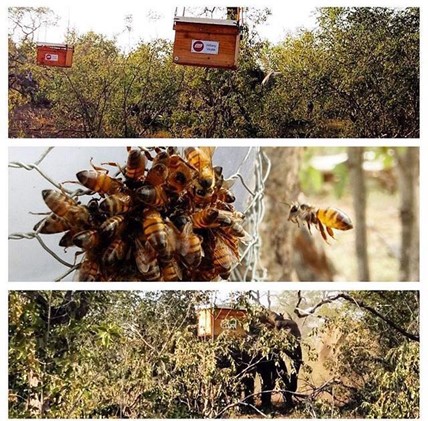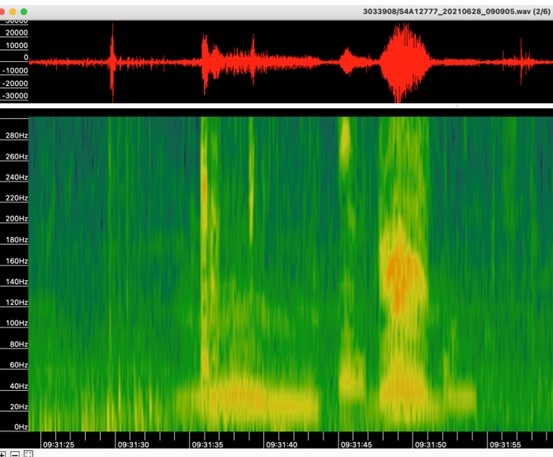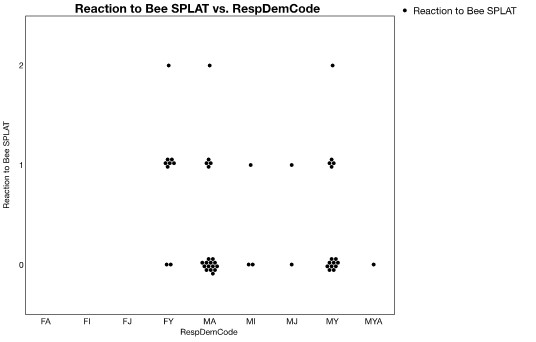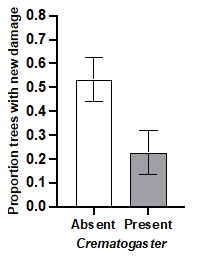Introduction
Developing passive options for deterring elephants from breaching fences and damaging crops and infrastructure is an ongoing issue in Africa and parts of Asia. Honeybee (Apis mellifera) hives have been used extensively in Kenya and other African countries as African elephant (Loxodonta africana) deterrents (Fig. 1), because the elephants avoid bee stings fastidiously. In addition to providing a means of protecting crops and property from marauding elephants, rural Africans have a renewed interest in apiculture, and are actively encouraged to develop apiaries by projects implemented by Elephants Alive in South Africa http://elephantsalive.org/science/bees-and-trees/ and Save the Elephants in Kenya https://www.savetheelephants.org/project/elephants-and-bees/. Subsistence farmers are thus developing additional products through honey production. To build upon earlier work on using active honeybee hives to deter elephants, we launched a project examining the potential of honeybee alarm pheromones as an additional component in the toolbox for elephant deterrence. Our preliminary experiments were successful, showing that elephants are passively deterred upon detection of a prototype synthetic honeybee alarm pheromone blend. The results of that work were published in Current Biology (Wright et al. 2018), and a brief report from Scientific American can be found at https://www.scientificamerican.com/podcast/episode/honey-bee-alarm-signal-could-protect-elephants/.
During the past three years (Dec 2019 – Dec 2022), we conducted experiments with a 3-component synthetic honeybee alarm pheromone blend, to assess the response of African elephants to these semiochemicals formulated into slow-release matrices for field deployment. Our field season was interrupted owing to COVID-19 restrictions, and no field work could be completed during the planned field sessions in 2020. We were able to conduct several experiments during 2021-2022 to address the aims of this project.


Figure 1. Beehives used to deter elephants under field conditions (images: Elephants Alive)
Overall aims of this project:
- Quantify behavioral response of elephants to prototype alarm pheromone mixes (APMs).
- Assess effectiveness of APMs
- Disseminate findings to relevant conservation managers and other organizations
- Encourage local apiculture as a collateral benefit.
Research activities:
Aim 1: Refine blend and dosage of alarm pheromones: We conducted preliminary investigations of formulations of SPLAT (Specialized Pheromone and Lure Application Technology®, an ISCA Technologies product, see Fig. 2 below) incorporating isoamyl acetate, 2-heptanone and 2-nonanol, major components of the alarm pheromone semiochemical blend produced by A. mellifera (Table 1, Nouvian et al., 2016, J. Exp. Biol. 219: 3505-3517).

Formulations containing equal proportions (20% each by volume), of isoamyl acetate, 2-heptanone and 2-nonanaol were tested under field conditions to determine response from elephants. Refining the blend and dosage is central to developing an effective and sustainable field-durable means of deploying the pheromone blend.
Aim 2: Assess effectiveness of APMs:
Results in 2021 were consistent with our earlier results (Wright et al. 2018; 2019 report to Eva Crane Trust), with some elephants showing a distinct aversion to the 3-component blend. A brief example video recording is embedded below, double click to activate, showing a particularly heightened response. The video shows a small breeding herd of elephants at a waterhole, initially with control treatment socks nearby. At 26 seconds, the young bull to the left of the group moves towards the left end of the waterhole. He shows signs of uncertainty as approaching the treatment (in a white sock on a log at the left of the waterhole); at 42 seconds, he demonstrates a marked alarm response (trunk raised; backing away from cue) and appears to provide an alarm warning.

The rest of the herd responds rapidly and vigorously, departing the waterhole at pace. This series of events suggests that the young bull had a strong learned response to the cues experienced, and that he provided a warning to the rest of the herd that there was eminent danger. We have attempted to obtain low-frequency (>20Hz, sub-sonic for humans) recordings of warning rumbles (O’Connell-Rodwell 2007) using sensitive recorders (Wildlife Acoustics®) at waterholes, and have limited data showing rumbles correlated with deterrence responses. Work in Namibia on elephant communication has demonstrated that elephants use low frequency warning calls to alert fellow herd members, and even other herds, of danger such as predators. Our results are consistent with those findings (O’Connell-Rodwell, pers comm.).


Figure 2. A screenshot of low-frequency putative warning rumble from an elephant responding to
the repellent cue. At approximately 09:31:36 and09:31:48, distinct low rumbles at 20Hz are shown.
The 2021 season thus provided us with clear evidence that our three-component blend has the potential to produce a strong avoidance/repellence response from elephants. The frequency of these responses was not high (approximately 12% of observed individual interactions produced these responses), but a single responder is able to warn the rest of the herd to the Prescence of danger, producing a herd-scale evacuation in some cases.
Results in 2022 showed a similar proportion (17% of observed individuals showed deterrence behavior) of responses to the repellent blend, but few dramatic responses were observed. We suspect this is because of continued low incidence of wild bee hives in the study area, a semi-arid savanna zone. Our earlier (2018) results showing up 83% of individuals responding to our treatments were from a location with many managed beehives deployed for protection of trees against elephants. The 2019-2022 observations were all conducted in locations with very low bee incidence, for logistical reasons.
The distribution of responses by different demographics within a herd of elephants may be highly significant. Young adventurous bulls may be more likely to encounter hives than cows, for example. Analyzing the 2022 (June-July data, n = 119 observations) to assess responses by age and sex demographics, showed that young (10-18 year old) cows, adult bulls and young bulls were roughly equally responsive (Fig. 3). No responses were observed from adult females (other than the matriarch, see below), and younger cows.


Figure 3. Distribution of responses of elephants (scale: 0 = no response; 1 = mild response; 2 = distinct response) to deterrent alarm pheromone blend, by demographic group (FA = female adult; FI = female infant; FJ = female juvenile; FY = female young sub-adult; MA = male adult; Mi = male infant; MY = male young; MYA = male young adult; SPLAT = Specialized Pheromone and Lure Application Tech, the method used to deploy the pheromone blends)).
It was observed on multiple occasions that the matriarch of some herds would detect the repellant treatments, and then place herself between the rest of the herd and the source of the cues, apparently preventing the herd members from approaching. These matriarch cows did not show any other sign of distress or repellence. Interpretation of this behavior is subjective but suggests that the matriarch is cautious of allowing younger cows and calves to approach the cues.
We also conducted trials at water towers. The stud area, within the Olifants West Nature Reserve, part of the Greater Kruger Park, is a semi-arid savanna, with limited free-standing water across most of the landscape. Elephants will frequently raid infrastructure, ripping out water pipes and draining water reservoirs and water towers. We placed our repellent SPLAT formulations around frequently raided water towers, as dollops of the blend matrix on branches piled to attempt to reduce elephants, at 1m intervals around tanks. We were able to achieve protection of the resource for at least three weeks in this way. It is possible that the elephants became habituated to the repeated “false alarms” provided by the cues, or that bee-inexperienced elephants were raiding over time. Temporary placement of live hives to provide negative reinforcement may reduce this problem.
In addition to testing honey bee alarm pheromone blends, we have also commenced testing formic acid SPLAT formulations as potential elephant repellants. This is based on the observation that marula trees (Sclerocarya birrea) with earlier elephant damage that have been colonized by ants (Crematogaster spp.) incurred reduced “new” damage from elephants (Fig. 4).


Figure 4. Proportion of marula trees with recent damage from elephants,
with and without colonies of Crematogaster present.
We tested SPLAT mixes with 20% formic acid using similar methods for the honey bee alarm pheromone blends as above during 2022. We obtained surprisingly strong repellence responses from a substantial proportion of elephants encountering the formic acid SPLAT. While this is not a planned component of the Eva Crane Trust funded work, we were able to conduct these observations at the same time as the bee alarm pheromone observations.
Ultimately combining a range of different repellence cues (e.g. active honey bee hives; alarm pheromone blends; formic acid) with other methods such as physical exclusion, is likely to provide a reliable integrated system to ensure elephant containment, reduction in fence breaches, and reduced elephant-human conflict.
Aim 3: Disseminate findings to relevant conservation managers and other organizations
Presentations made at scientific meetings:
Tuskers Outdoor Workshop, January 2019, Hoedspruit, South Africa.
Southern Africa Wildlife Management Association, Kruger National Park, South Africa. September 2021.
Entomological Society of America (symposium on pheromone use in animal management), Denver, Colorado, USA, November 2021.
Informal presentations on the results of this work have been made to conservation area managers, researchers, local stakeholders and students on a number of occasions, at Olifants West Nature Reserve, Greater Kruger Park.
Book chapter:
Mafra-Neto, A., Wright, M., Fettig, C., Progar, R., Munson, S., Blackford, D., Moan, J., Graham, E., Foote, G., Borges, R., Silva, R., lake, R., Bernardi, C., Saroli, J., Clarke, S., Meeker, J., Nowak, J., Agnello, A., Martini, X., Rivera, M., Stelinski, L. 2022. Repellent semiochemical solutions to mitigate the impacts of global climate change on arthropod pests. In: Advances in Arthropod Repellents. Elsevier. pp. 279-322.
Journal manuscripts in preparation.
Dr. Mark G Wright, University of Hawaii at Manoa
Collaborators:
Paul Allin and Craig Spencer, Transfrontier Africa
Dr. Michelle Henley and Robin Cook, Elephants Alive
Dr. Agenor Mafra-Neto, ISCA Technologies
Literature cited
Nouvian, M, Reinhard, J, Giurfa, M. 2016. The defensive response of the honeybee Apis mellifera. J Exp Biol 219: 3505-351
O’Connell-Rodwell, C. 2007. Keeping an “ear” to the ground: Seismic communication in elephants. Physiology 22: 287-294.
Wright, M.G., Spencer, C.R., Cook, R.M., Henley, M.D., North, W. & Mafra-Neto, A. 2018. African bush elephants response to a honeybee alarm semiochemical blend. Current Biology 28: R778-780.

